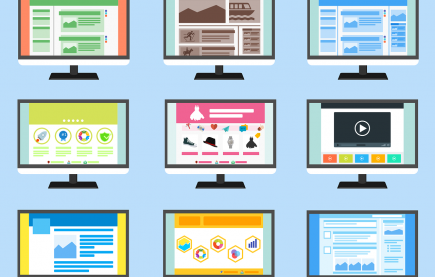Best Web Design Practices
In this post you will be given a list of the most respected practices web designers use today. These methods will not only help optimize your site’s speed and visibility, but they also have the potential to increase traffic to your site. By following these steps it will ensure the best user experience possible for your target audience.
Secondary Designs
Users don’t want to feel that they have switched to a different site when viewing secondary pages. The homepage is the backbone of the entire site design and every subsequent page is a continuation with in-depth information. All important elements (logo, navigation, header, footer) should remain exactly the same throughout all pages so that the user becomes confident in navigating throughout the site.
Ensure Type Legibility
You should choose your text and background colors very carefully. You don’t want to use backgrounds that obscure your text or use colors that are hard to read. Remember that no matter how creative a typeface may be, it must be legible! Crazy fonts may look cool, but they will end-up overpowering the message.
Say “NO” to Splash & Intro Pages
Did you know that it only takes most users 1/20th of a second to form an opinion about your website? With that in mind, you may quickly lose users to a splash page before they even get a chance to visit your website. Ultimately, splash pages slow down users from getting the content they’re after. In fact, Google tends to rank sites with splash pages lower. Splash pages may seem unique and exciting, but it just makes you one click further from gaining a customer’s business.
Avoid the Use of Flash
Not too long ago flash elements were all the rage, but now they are becoming a thing of the past. With the advent of smart phones and tablets, it is recommended that you do not use flash, as these elements cannot be rendered on most mobile browsers. More over, it is not safe to assume that all users have installed Adobe Flash on their computers. Keep in mind that flash elements cannot be read by Google; thus, hindering your SEO results.
Keep Users Concentrated
Do not use more than one visual effect at a time. Remember that effects are used to catch the eye of the viewer, not to distract them. Users cannot concentrate on more than one effect at a time, so it will become overwhelming to your target audience. Bottom line, eliminate distractions that pull visitors away from the main message.
One Motion Graphic at a Time
Extensive animations and pop-ups do more harm than good, and can get in the way of important content. Having one motion element (animation or video) that starts only when selected, keeps the user in control. An exception to this rule is having an automatic slideshow on your homepage that starts upon page load.
Silence is Golden
Unless you are a music artist, and even then, avoid using automatic audio on your website. Audio includes background music, on-click sounds, load-sounds, and more. If you think the sounds will be beneficial to the user and support the website’s content, allow the user to “opt-in” for the audio. This can be done by providing a small media player where the users can opt to listen to the material you’ve posted to your website.
Minimal Design Effects
Good web design is as much about discipline as it is design. Design effects such as drop shadows, reflections, or boxes can help to distinguish content, but using multiple examples within the same design takes away the sites professionalism. It is best to pick one effect that best suits the aesthetic of the brand and use that consistently throughout the site.
Web Safe Fonts
Although font face replacement is making great headway, it is highly recommended that you only use this technique for elements that are NOT body content. For example, you may want to use a non web-safe font that matches your logo type. This font replacement should only be used for the page titles or section headers, but never in the body content. Abusing font-replacement techniques will cause your site load time to dramatically increase.
Follow the Rules of SEO
If your site is not search engine optimized, you’re cutting off your brand from organic traffic and a potential global audience. As such, make sure you’ve generated a site map, and that your title tags, alt tags, image captions, meta descriptions, and heading titles get filled out. It is also highly recommended that you hire an SEO expert to do “link building” for your site, along with selecting unique keyword phrases to increase organic search visibility.
Quick Load Time
Focus on optimizing your website’s loading time. Studies have indicated that visitors will quickly lose interest in your website if the majority of a page does not download within 15 seconds or less. You can increase side load time by having small image and file sizes, using minimal animation or page effects, and writing clean code. Keep in mind that inferior web browsers such as Internet Explorer will inherently load pages slower because of it’s poor code rendering capabilities, especially when advanced styling is involved.
Write Your Own Code
Here at Lform, we hand code every site from start to finish. This allows us to write clean, optimized code that will increase your site’s performance. Relying on code generating programs like Dreamweaver can sometimes hinder a site’s performance as it tends to add extraneous (or unnecessary) code. Moreover, blindly grabbing pre-written code can cause errors on the site, which can be difficult to diagnose and solve.
Web Accessibility Standards
Web accessibility means that people with disabilities can use the Web. More specifically, Web accessibility means that people with disabilities can perceive, understand, navigate, and interact with the Web, and that they can contribute to the Web. It is important that your website adheres to web accessibility standards so as to include all web users. The top practiced standards include reasonable site load time, adequate text-to-background contrast, easy to read font size and spacing, minimum flash and add-on’s, image alt tags, and custom not-found/404 page.
Cross Browser Compatibility
Despite what Microsoft would like you to believe, not everybody on the Web uses Internet Explorer on a Windows-based PC. In fact most web users use Mozilla Firefox or Google Chrome. As such it is imperative that you check your website in multiple browsers and on multiple platforms — to make sure everything appears uniformly.
Go Mobile
Not too long ago, a mobile site was a nice-to-have add on. That’s no longer the case. Your company needs to be there. Make sure your site is optimized for both smart phones and tablets. This makes your site even more accessible to your users, and you bet they’ll appreciate it!
Social Networking
Having a Social Network function helps yours users connect with one another, and gives your users a reason to come back to your site. The most common social networks include Facebook (by creating a fan page), Twitter (micro-bloggin), LinkedIn (social networking for professionals), and blogging (becoming an online resource with valuable information that’s regularly updated). However, BEWARE of social media overkill! This is to say that social media should add value to your brand, and avoid bombarding users with social media outlets just for the sake of it. Do research, and make sure only to use social networks that your users visit regularly.
Statistics
Here at Lform, we set you up with two analytic accounts: Google Analytics and StatCounter. These tools will help you measure your business goals after your site goes live. Once you’ve confirmed that your tags are working, pull weekly reports and start looking critically at how people are using your site. If you find that some parts of your website are rarely visited, think of how to make that area more inviting to your users. Be relentless in your pursuit of delivering an optimal user experience.
Think you might be able to add insight to this post? Don’t be shy, let us know what you think!



